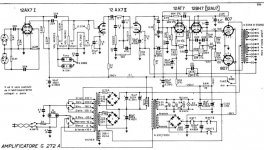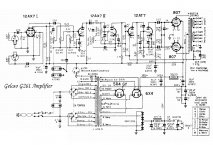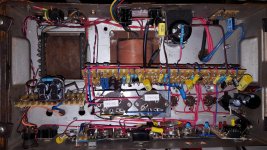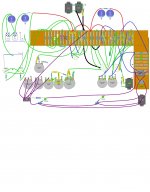Hello everybody. I recently bought one old Geloso 272A amplifier (originally a PA, attached the schematic).

Internally I've to replace completely all the components (they are in a very poor state), the boards and the cabling. At the end I save the trasformers, choke, tubes and probably the pots. So I'd like to transform it in a guitar amp, with the pre part and the phase inverter of a Marshall SJ Silver Jubilee (attached the schematic).
View attachment Marshall_25aniv_silverjubilee_50_100w_2555.pdf
So a few questions to you gurus to start the project: 1) what have I to do to adapt the output of the SJ phase inverter to the input of the original Geloso power stage, based on 807 tubes, eliminating all of existing Geloso pre and phase inverter up to the 12BH7 included? 2) what about the Geloso power stage, to be transformed from linear to distorted stage? 3) what about fixed biasing of 2)? 4) what about the OT primary impedance in the new configuration?
Any comment (also worst) will be well accepted, also about the whole project itself May be also suggestion of already realized project with similar tubes (I know the 807 are quite similar to 6L6). Thanks in advance to all contributors.
May be also suggestion of already realized project with similar tubes (I know the 807 are quite similar to 6L6). Thanks in advance to all contributors.

Internally I've to replace completely all the components (they are in a very poor state), the boards and the cabling. At the end I save the trasformers, choke, tubes and probably the pots. So I'd like to transform it in a guitar amp, with the pre part and the phase inverter of a Marshall SJ Silver Jubilee (attached the schematic).
View attachment Marshall_25aniv_silverjubilee_50_100w_2555.pdf
So a few questions to you gurus to start the project: 1) what have I to do to adapt the output of the SJ phase inverter to the input of the original Geloso power stage, based on 807 tubes, eliminating all of existing Geloso pre and phase inverter up to the 12BH7 included? 2) what about the Geloso power stage, to be transformed from linear to distorted stage? 3) what about fixed biasing of 2)? 4) what about the OT primary impedance in the new configuration?
Any comment (also worst) will be well accepted, also about the whole project itself
Last edited:
Pins 3 & 8 of the 12bh7 is the signal heading into the power amp stage. I would leave everything there as is. Tie your presence controls for sj the same as the geloso.
I would keep every thing on the sj from c30/c31 forward geloso and see how you feel about tone before going any further.
I would keep every thing on the sj from c30/c31 forward geloso and see how you feel about tone before going any further.
Hello OrbitalLex. Some weeks are passed from my post and I moved a little differently. After c30/c31 of sj (after the PI) I go directly into the 807 (I find a schematic, attached, of a different model of Geloso that follow more or less this approach).

It was also a matter of available space. The SJ is quite complex and requires space that was not available. I moved the tone stack near the pots and cabled on-air. I near to complete all the cabling, only the output jacks and impedance selection missing, and the commands for the lead channel and double master volume (I included this mod).

Next week, before cabling the outputs, I'd switch on the amp without the tubes and measure all the voltages to verify how the 807 should work. I've also in mind to use differently the 807 to reduce the output power (now the declared value is 100W).

It was also a matter of available space. The SJ is quite complex and requires space that was not available. I moved the tone stack near the pots and cabled on-air. I near to complete all the cabling, only the output jacks and impedance selection missing, and the commands for the lead channel and double master volume (I included this mod).

Next week, before cabling the outputs, I'd switch on the amp without the tubes and measure all the voltages to verify how the 807 should work. I've also in mind to use differently the 807 to reduce the output power (now the declared value is 100W).
First request for help. Completed mounting and cabling and it works! This time a strange hybrid: the pre until the PI is a Marshall Silver Jubelee 2550, the final stage excluding the Bias is the original Geloso G272. To be my second amp I consider it almost a success.
I wonder to hear your opinion on a couple of things: 1) One of the 807 has a red plating at medium-low volume after a few minutes of sound, while raising the volume even at max everything returns to normal. The redness follows the valve so I guess it may be a problem of his own. Tips? I installed separate Bias trimmers for the two valves so I could also make different adjustments. Currently the Bias Voltage is at -30Vdc as per specification (I think). 2) The volume is really high while at the lower level there is no distortion at end stage. Do you have any suggestions on how to use the 807 in a different configuration (keeping the trafo) to have lower power and a more pronounced distortion.
Thanks in advance.
I wonder to hear your opinion on a couple of things: 1) One of the 807 has a red plating at medium-low volume after a few minutes of sound, while raising the volume even at max everything returns to normal. The redness follows the valve so I guess it may be a problem of his own. Tips? I installed separate Bias trimmers for the two valves so I could also make different adjustments. Currently the Bias Voltage is at -30Vdc as per specification (I think). 2) The volume is really high while at the lower level there is no distortion at end stage. Do you have any suggestions on how to use the 807 in a different configuration (keeping the trafo) to have lower power and a more pronounced distortion.
Thanks in advance.
1. If the RP follows the tube, toss the tube.
2. Experiment. Play with negative feedback adjustments. Change to true PPIMV master volume. Rewire sockets for 6L6(electrically identical to 807), KT66 or EL34. Convert power supply to a tube rectifier or reduce the stiffness with sag mods. Study power amp stages like the JTM45 for example and compare to your circuit.
I would be inclined to think most improvement in this department would be found in power supply mods. There is a lot of dynamic tone being lost in a p/s as stiff as yours. I would definitely be interested in doing some work on that if it were mine. My best advice is to experiment.
Guys will come and here and tell you exactly what to do and nothing else will work, when in reality there is no shortage of things to try that may achieve what you are looking for.
2. Experiment. Play with negative feedback adjustments. Change to true PPIMV master volume. Rewire sockets for 6L6(electrically identical to 807), KT66 or EL34. Convert power supply to a tube rectifier or reduce the stiffness with sag mods. Study power amp stages like the JTM45 for example and compare to your circuit.
I would be inclined to think most improvement in this department would be found in power supply mods. There is a lot of dynamic tone being lost in a p/s as stiff as yours. I would definitely be interested in doing some work on that if it were mine. My best advice is to experiment.
Guys will come and here and tell you exactly what to do and nothing else will work, when in reality there is no shortage of things to try that may achieve what you are looking for.
Rewire sockets for 6L6(electrically identical to 807), KT66 or EL34.
Can't do that Dave. (The 807 has a 5 pin socket, not octal)
807s are common and cheap. But check the bias and current (it's possibly, no, likely, that the valves are a long way from matched)
Then do some homework (e.g. read what Rob Robinette has to say about how amps work).
Hello guys, a few time from my last post. Unfortunately my job and my wife required my attention. In the mean time I worked to reduce the power of the amp using separately (and not cascaded) two wings coming out from the PT and creating two different power circuits, one for the pre and the other for the power section. Now the two 807 have a plate voltage of 360Vdc, screen voltage of 270Vdc and Grid -22.5Vdc (Class AB1, I refer to the datasheet attached, in the upper part evidenced). View attachment STC 807 (page 6).pdfCan't do that Dave. (The 807 has a 5 pin socket, not octal) 807s are common and cheap. But check the bias and current (it's possibly, no, likely, that the valves are a long way from matched) Then do some homework (e.g. read what Rob Robinette has to say about how amps work).
What is not clear to me is how to define the values of the Grid Stopping Resistor --> I leave the 100 Ohm present in the original Geloso and of the Grid Leak resistors --> I set them to 47 KOhm. A second interesting option is to move to 47W of power output (Class AB2, in the lower part of the attachment) but, again, is not clear to me what I have to do, other than define the right volages for plate, screen and grid bias? Can I reach this result using as a driver the 12AX7 phase inverter present in the SJ preamp I realized (in attachment the SJ 50W schematic I followed up to the C30/C31 coupling caps)?
View attachment Marshall_25aniv_silverjubilee_25_50w_2550.pdf
Please, I appreciate your suggestion and also addressing to literature to learn more about this topics. I read a lot from Rob Robinette but not found (or I was not able to see) the answer to my questions? Thanks in advance. PS I attached also the actual layout of the amp
Attachments
Last edited:
Looking at the original schematic I think you are already in Class AB2. Plate Voltage is around 600V with screen voltage of 280V and bias of -32V.
That stacks up with the Class AB2 Right Most column data in the STC807 Application Report. It further says Raa 6400 Ohms, 80 Watts out at 3.5% THD. Plate Current 60mA (idle) to 200mA at full output, (idle at 30mA each tube) Screen Current 5mA (idle) to 21 mA at full output.
For others: The full application report is on a few sites e.g., http://nekhbet.com/STC807.pdf
Cheers,
Ian
That stacks up with the Class AB2 Right Most column data in the STC807 Application Report. It further says Raa 6400 Ohms, 80 Watts out at 3.5% THD. Plate Current 60mA (idle) to 200mA at full output, (idle at 30mA each tube) Screen Current 5mA (idle) to 21 mA at full output.
For others: The full application report is on a few sites e.g., http://nekhbet.com/STC807.pdf
Cheers,
Ian
Hello Ian.
Many changes from the original schematic. To reduce output power I set the following parameters for the 807 power stage: plate voltage of 360Vdc, screen voltage of 270Vdc and Grid -22.5Vdc. This is corresponding to two different possibilities on page 6 of the STC report (in Yellow in my attachment): AB1 and AB2, related to other parameters.
One of them I can change easily: the reflected impedance of the OT. But how can I work on the others? My 12AX7 of the Marshall SJ pre-amp is able to drive the 807? What are the limits? Consider that at the moment the 807s have: - Grid Stopping Resistor --> 100 Ohm (like the original Geloso) - Grid Leak resistors --> 47 KOhm I'm open to suggestion but also indication of books/contents to be studied.
Many changes from the original schematic. To reduce output power I set the following parameters for the 807 power stage: plate voltage of 360Vdc, screen voltage of 270Vdc and Grid -22.5Vdc. This is corresponding to two different possibilities on page 6 of the STC report (in Yellow in my attachment): AB1 and AB2, related to other parameters.
One of them I can change easily: the reflected impedance of the OT. But how can I work on the others? My 12AX7 of the Marshall SJ pre-amp is able to drive the 807? What are the limits? Consider that at the moment the 807s have: - Grid Stopping Resistor --> 100 Ohm (like the original Geloso) - Grid Leak resistors --> 47 KOhm I'm open to suggestion but also indication of books/contents to be studied.
OK - For class AB2 you need dedicated low output impedance drivers like the `12BH7 cathode followers in the original schematic. You could safely increase the grid leak resistances on the 807s to 100K which will lighten the load on the 12AX7 phase splitter. Otherwise I would leave as you have it - around 26 Watts out according to the application report. You won't notice a lot of difference between that and 48 Watts.
If you really do want the extra 20 odd watts from Class AB2 then add mosfet source followers AC coupled from the phase splitter and direct coupled to the 807 grids. Note the various comments on running ClassAB2 in the report (Anode stopper resistors etc) . Personally I don't think it is worth it - stick with KISS (Keep It Stupid Simple). For reference there are some Standel Amp designs floating around the web that used 807 outputs. I was looking at them as I have a box of 12 NOS Amperex 807s sitting on the shelf.
Cheers,
Ian
If you really do want the extra 20 odd watts from Class AB2 then add mosfet source followers AC coupled from the phase splitter and direct coupled to the 807 grids. Note the various comments on running ClassAB2 in the report (Anode stopper resistors etc) . Personally I don't think it is worth it - stick with KISS (Keep It Stupid Simple). For reference there are some Standel Amp designs floating around the web that used 807 outputs. I was looking at them as I have a box of 12 NOS Amperex 807s sitting on the shelf.
Cheers,
Ian
- Status
- This old topic is closed. If you want to reopen this topic, contact a moderator using the "Report Post" button.
- Home
- Live Sound
- Instruments and Amps
- Geloso 272A & Marshall Silver Jubilee pre
